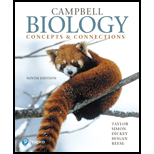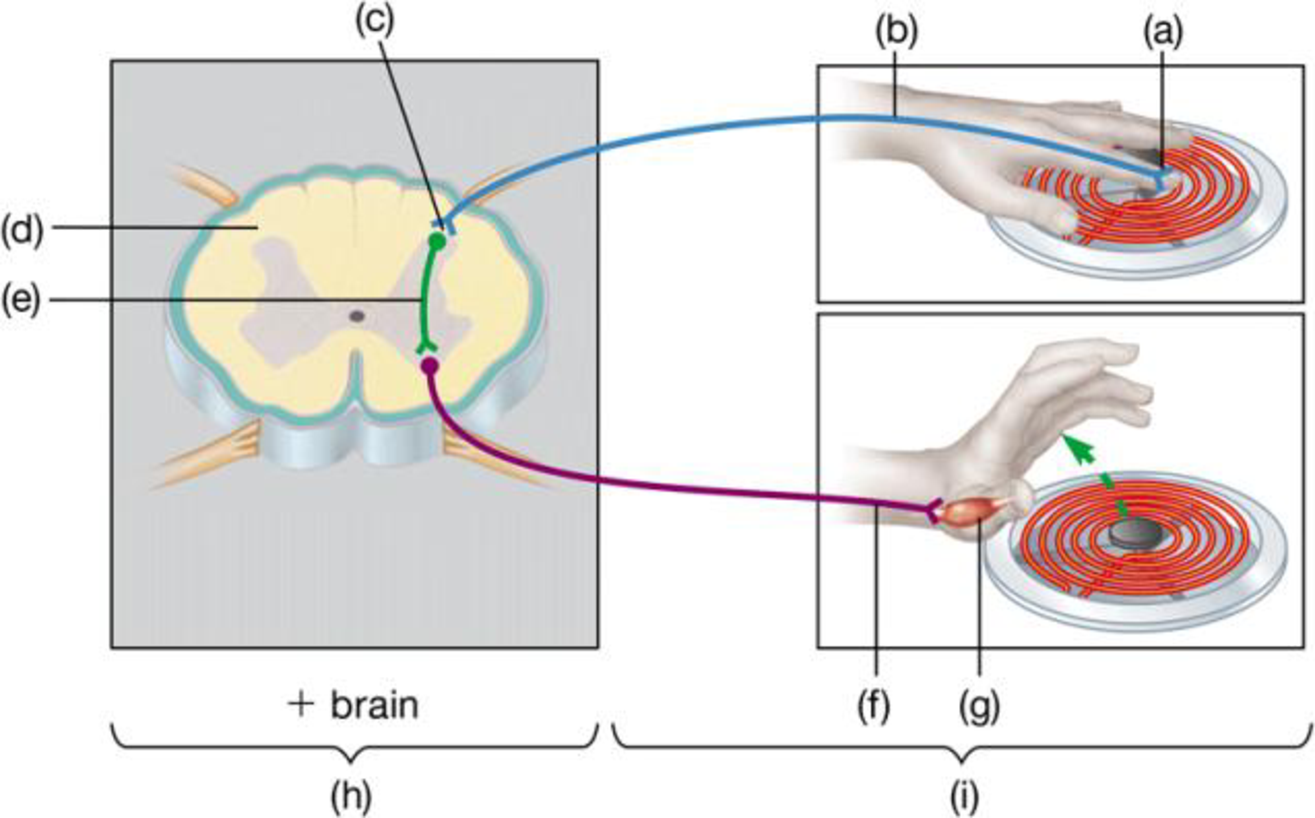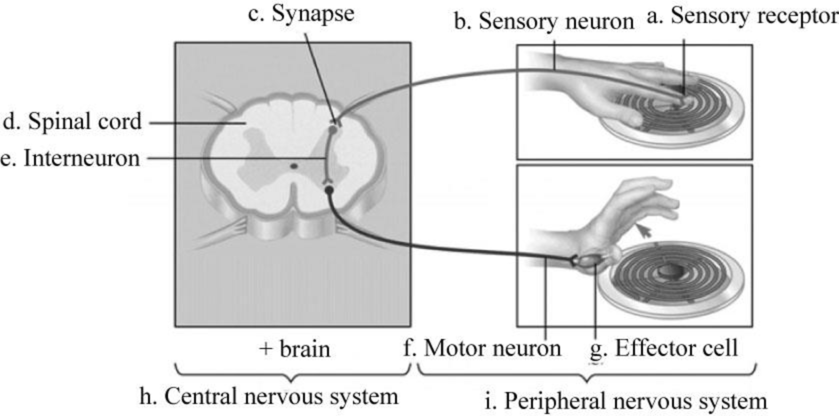
Test your understanding of the nervous system by matching the following labels with their corresponding letters: CNS, effector cells, interneuron, motor neuron, PNS, sensory neuron, sensory receptor, spinal cord, synapse.

To label: The system involved in reflex action and also to list the points that take part in conduction of nerve signals during the process.
Concept introduction: A collection of nerves, the brain, and the spinal cord that together help in regulation of signals from one part of the body to another is called the nervous system. The primary unit of the nervous system is a specialized cell that is termed as a neuron.
Answer to Problem 1CC
Pictorial representation: Fig.1 shows the systems involved in transmission of signal and response generated by the brain.

Fig.1: System involved in nerve conduction
Explanation of Solution
(a)
Correct answer: Sensory receptor.
Sensory receptors are present on dendrites to neurons that are specialized in receiving signals from the environment. The receptor that receives a signal from the external environment is termed as external sensory receptor, whereas the receptor that receives a stimulus from the internal environment is termed as an internal sensory receptor. Hence, the correct answer is a sensory receptor.
(b)
Correct answer: Sensory neuron.
Sensory neurons are the neurons that specialize in transferring the stimulus from the sensory receptor to the brain or spinal cord. The movement of stimulus through the sensory neurons is termed as sensory induction. Hence, the correct answer is a sensory neuron.
(c)
Correct answer: Synapse.
Synapse is the site where the signal passes to the next neuron or to the effector cell with the help of an electrical or a chemical signal (neurotransmitter). Hence, the correct answer is synapse.
(d)
Correct answer: Spinal cord.
The spinal cord is a part of the central nervous system. Transmission of a nerve signal from the sensory neuron to the brain for further processing is done with the help of the spinal cord and the neurons that are present in it. Hence, the correct answer is spinal cord.
(e)
Correct answer: Interneuron
Interneuron is a part of the central nervous system that helps in conveying the signals between sensory neuron and motor neuron. Interneuron is found in the spinal cord. Hence, the correct answer is an interneuron.
(f)
Correct answer: Motor neuron.
Motor neuron conducts the movement of signals from the brain and spinal cord to the cell where the response is needed. Cell body of a motor neuron is located in the spinal cord and the axon part of the cell is located toward muscle or gland where action is needed. Hence, the correct answer is a motor neuron.
(g)
Correct answer: Effector cell.
Effector cell is present in the glands and muscles. It receives the signal from the motor neuron and generates a physiological response in the body part. Hence, the correct answer is an effector cell.
(h)
Correct answer: Central nervous system.
The central nervous system (CNS) is responsible for actions that the body takes in response to an external stimulus. It receives the signal from the receptors, processes the reflex by the CNS, and transmits a signal to the effector cell. The central nervous system consists of two main parts: the spinal cord and the brain. Hence, the correct answer is the central nervous system.
(i)
Correct answer: Peripheral nervous system.
The peripheral nervous system consists of nerves and their neurons. It includes receptor cell, sensory neuron, interneuron, motor neuron, and effector cell. PNS connects the body to CNS. Hence, the correct answer is the peripheral nervous system.
Want to see more full solutions like this?
Chapter 28 Solutions
Campbell Biology: Concepts & Connections (9th Edition)
- calculate the questions showing the solution including variables,unit and equations all the questiosn below using the data a) B1, b) B2, c) hybrid rate constant (1) d) hybrid rate constant (2) e) t1/2,dist f) t1/2,elim g) k10 h) k12 i) k21 j) initial concentration (C0) k) central compartment volume (V1) l) steady-state volume (Vss) m) clearance (CL) AUC (0→10 min) using trapezoidal rule n) AUC (20→30 min) using trapezoidal rule o) AUCtail (AUC360→∞) p) total AUC (using short cut method) q) volume from AUC (VAUC)arrow_forwardQUESTION 8 For the following pedigree, assume that the mode of inheritance is X-linked recessive, and that the trait has full penetrance and expressivity and occurs at a very low frequency in the hum population. Using XA for the dominant allele and Xa for the recessive allele, assign genotypes for the following individuals (if it is not possible to figure out the second allele of a genotype, that with an underscore): 2 m 1 2 1 2 4 5 6 7 8 9 IV 1 2 3 5 6 7 8 CO 9 10 12 13 V 1, 2 3 4 5 6 7 8 9 10 11 12 13 a. Il-1: b. 11-2: c. III-3: d. III-4: e. If individuals IV-11 and IV-12 have another child, what is the probability that they will have a boy with the disorder?arrow_forwardAnswerrarrow_forward
- please,show workings ahd solutions calculate the questions showing the solution including variables,unit and equations all the questiosn below using the data a) B1, b) B2, c) hybrid rate constant (1) d) hybrid rate constant (2) e) t1/2,dist f) t1/2,elim g) k10 h) k12 i) k21 j) initial concentration (C0) k) central compartment volume (V1) l) steady-state volume (Vss) m) clearance (CL) AUC (0→10 min) using trapezoidal rule n) AUC (20→30 min) using trapezoidal rule o) AUCtail (AUC360→∞) p) total AUC (using short cut method) q) volume from AUC (VAUC)arrow_forwardQuestion about consensus and the relationship to transcriptional activityarrow_forwardQuestion about archaea and eukaryotic general transcription homologsarrow_forward
- Question about general transcription factors and their relationship to polymerasesarrow_forwardIdentify the indicated structure?arrow_forwardrewrite: Problem 1 (Mental Health): The survivor victim is dealing with acute stress and symptoms of a post-traumatic stress disorder (PTSD) due to their traumatic experience during the January 2025 wildfire. Goal 1: To alleviate the client's overall level, frequency, and intensity of anxiety and PTSD symptoms so that daily functioning remains unimpaired. Objective 1: The client will learn and regularly use at least two anxieties management techniques to reduce anxiety symptoms to less than three episodes per week. Intervention 1: The therapist will provide psychoeducation about anxiety and PTSD, including their symptoms and triggers. The therapist will also teach and assist the client in adopting relaxation techniques, such as deep breathing exercises and progressive muscle relaxation, to better manage anxiety and lessen PTSD symptoms.arrow_forward
- O Macmillan Learning You have 0.100 M solutions of acetic acid (pKa = 4.76) and sodium acetate. If you wanted to prepare 1.00 L of 0.100 M acetate buffer of pH 4.00, how many milliliters of acetic acid and sodium acetate would you add? acetic acid: mL sodium acetate: mLarrow_forwardHow does the cost of food affect the nutritional choices people make?arrow_forwardBiopharmaceutics and Pharmacokinetics:Two-Compartment Model Zero-Order Absorption Questions SHOW ALL WORK, including equation used, variables used and each step to your solution, report your regression lines and axes names (with units if appropriate) :Calculate a-q a) B1, b) B2, c) hybrid rate constant (1) d) hybrid rate constant (2) e) t1/2,dist f) t1/2,elim g) k10 h) k12 i) k21 j) initial concentration (C0) k) central compartment volume (V1) l) steady-state volume (Vss) m) clearance (CL) AUC (0→10 min) using trapezoidal rule n) AUC (20→30 min) using trapezoidal rule o) AUCtail (AUC360→∞) p) total AUC (using short cut method) q) volume from AUC (VAUC)arrow_forward
 Human Physiology: From Cells to Systems (MindTap ...BiologyISBN:9781285866932Author:Lauralee SherwoodPublisher:Cengage Learning
Human Physiology: From Cells to Systems (MindTap ...BiologyISBN:9781285866932Author:Lauralee SherwoodPublisher:Cengage Learning Anatomy & PhysiologyBiologyISBN:9781938168130Author:Kelly A. Young, James A. Wise, Peter DeSaix, Dean H. Kruse, Brandon Poe, Eddie Johnson, Jody E. Johnson, Oksana Korol, J. Gordon Betts, Mark WomblePublisher:OpenStax College
Anatomy & PhysiologyBiologyISBN:9781938168130Author:Kelly A. Young, James A. Wise, Peter DeSaix, Dean H. Kruse, Brandon Poe, Eddie Johnson, Jody E. Johnson, Oksana Korol, J. Gordon Betts, Mark WomblePublisher:OpenStax College Human Biology (MindTap Course List)BiologyISBN:9781305112100Author:Cecie Starr, Beverly McMillanPublisher:Cengage Learning
Human Biology (MindTap Course List)BiologyISBN:9781305112100Author:Cecie Starr, Beverly McMillanPublisher:Cengage Learning Biology: The Dynamic Science (MindTap Course List)BiologyISBN:9781305389892Author:Peter J. Russell, Paul E. Hertz, Beverly McMillanPublisher:Cengage Learning
Biology: The Dynamic Science (MindTap Course List)BiologyISBN:9781305389892Author:Peter J. Russell, Paul E. Hertz, Beverly McMillanPublisher:Cengage Learning





